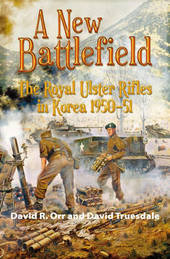
|
A New Battlefield: The Royal Ulster Rifles in Korea 1950-51
Paperback
Main Details
| Title |
A New Battlefield: The Royal Ulster Rifles in Korea 1950-51
|
| Authors and Contributors |
By (author) David R. Orr
|
|
By (author) David Truesdale
|
| Physical Properties |
| Format:Paperback | | Pages:272 | | Dimensions(mm): Height 234,Width 156 |
|
| Category/Genre | Asian and Middle Eastern history
Korean war |
|---|
| ISBN/Barcode |
9781908916921
|
| Classifications | Dewey:951.904242 |
|---|
| Audience | |
|---|
| Illustrations |
175 photographs, 4 maps
|
|
Publishing Details |
| Publisher |
Helion & Company
|
| Imprint |
Helion & Company
|
| Publication Date |
15 June 2013 |
| Publication Country |
United Kingdom
|
Description
Since the publication of The Rifles Are There in 2005, which dealt with the 1st and 2nd Battalions Royal Ulster Rifles in the Second World War, it was felt by many that a follow up volume dealing with the Korean conflict was overdue. A limited yet competent history had been produced in 1953 by the then Adjutant Captain Hugh Hamill, although this has been long out of print. A New Battlefield follows the Battalion as it prepares for the first major conflict fought by Britain since the defeat of the Japanese in 1945. During the summer of 1950 the Battalion was stationed at Sobraon Barracks in Colchester and was in the process of being issued with desert kit for a tour of duty at Khartoum in the Sudan and its numbers were just under four hundred men. For service in Korea these numbers had to be drastically increased and drafts of volunteers and reservists were brought in from various sources. Consequently this 'Irish' Battalion contained men from the Lancastrian Brigade, Welsh Brigade, Mercian Brigade, the Light Infantry and other Battalions of the Irish Brigade. The Irish Brigade also reinforced other regiments, the Royal Inniskilling Fusiliers sending two officers and fifty 'other ranks' to the King's (Liverpool) Regiment. Despite their varied backgrounds all ranks soon coalesced into a professional unit that took the campaign in its stride. From winter temperatures that dropped well below 40f to a summer heat that rose to 105f with a humidity to match these men survived all and dealt with a brave and tenacious enemy. The Battalion sailed for Korea in October 1950 and fought its first major action in January 1951 at Chaegunghyon, or as it was known to the Rifles, 'Happy Valley'. Here, for the first time they faced an enemy that often literally fought to the death, despite overwhelming firepower, bombing and widespread use of napalm. Three months later, on the banks of the Imjin River, the Rifles, in conjunction with the remainder of 29 Brigade, faced an army that came in such numbers that running out of ammunition before the enemy ran out of men became a reality. Besides numerous photographs there are also appendices including Honours and Awards, Operation 'Spitfire', an Order of Battle for 29 Brigade, and a Nominal Roll, which includes casualties.
Author Biography
David R Orr devotes much of his spare time to the field of military research and has supplied research material and photographs for several books. A member of The Royal Ulster Constabulary GC Historical Society, Society of Friends of the Airborne Museum, Oosterbeek, Police History Society, Society of Friends, Royal Irish Fusiliers Museum and The Military History Society of Ireland, he has delivered talks to local history groups, historical societies, museums and Regimental Associations. Author of "Duty Without Glory - The Story of Ulster's Home Guard in the Second World War and Cold War" and co-author of The Rifles are There: 1st & 2nd Battalions The Royal Ulster Rifles in the Second World War he is currently completing the researching and writing of the history of the Royal Ulster Constabulary Reserve Force and is working in collaboration on a history of the Ulster Volunteer Force and 36th Ulster Division. He is married with two sons, lives in Belfast and works full-time which impacts on his available time for writing and research, which also competes with a number of other interests and hobbies. David Truesdale opted for early retirement in 1998 and since then has written for films and television and produced two battlefield guides on behalf of the Royal Irish Fusiliers Museum - "The First Eagle: the 87th Foot at the Battle of Barrosa" and "Regulars by God! The 89th Foot at the Battle of Lundy's Lane". He is the author of "Brotherhood of the Cauldron: Irishmen in the 1st Airborne Division at Arnhem", "Angels and Heroes, the story of a machine gunner with the Royal Irish Fusiliers August 1914 to April 1915" (with Amanda Moreno), "Irish Winners of the Victoria Cross" (with Richard Doherty), "Leading The Way To Arnhem, a history of the 21st Independent Parachute Company" (with Peter Gijbels), "Arnhem Their Final Battle, the 11th Parachute Battalion 1943/44" (with Gerrit Pijpers). With David Orr he has written "The Rifles are There: 1st & 2nd Battalions The Royal Ulster Rifles in the Second World War" and "A New Battlefield; The Royal Ulster Rifles in Korea". They are currently in collaboration on a history of the Ulster Volunteer Force and 36th Ulster Division, 1913-1919. For relaxation he paints in watercolours following the Kelly school of innovation, photographs wildlife, listens to good music, drinks red wine and finds that Tomaso Albinoni (1671-1751) and his Oboe Concerto in D Minor, Op.9, No2, has been an inspiration during difficult times in any manuscript.
|